Tuffstuff Ltd: Business Environment and Strategic Analysis Report
VerifiedAdded on 2019/12/03
|18
|4250
|280
Report
AI Summary
This report examines the business environment of Tuffstuff Ltd., a cement manufacturer planning to expand into Rwanda. It begins by evaluating suitable organizational structures, recommending a functional structure. The report then delves into PEST analysis, discussing its benefits, limitations, and alternative tools like SWOT and Porter's Five Forces. The analysis covers political, economic, social, and technological factors. Furthermore, the report identifies key factors influencing the proposed venture, including Rwanda's economic growth and country information, offering insights into market potential and strategic considerations. The report provides a comprehensive overview of the business environment, strategic planning, and decision-making process for Tuffstuff Ltd's expansion into Rwanda.
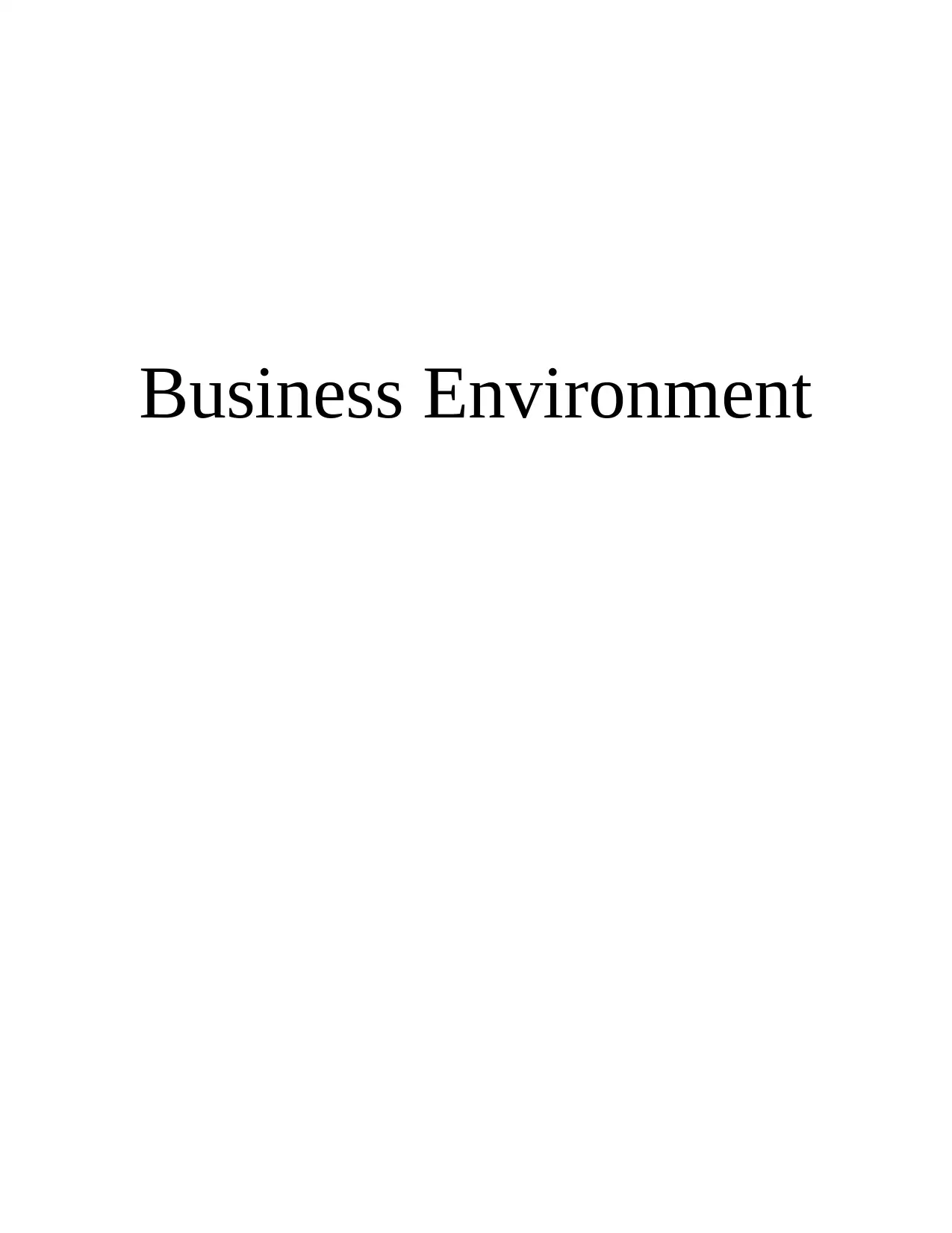
Business Environment
Paraphrase This Document
Need a fresh take? Get an instant paraphrase of this document with our AI Paraphraser
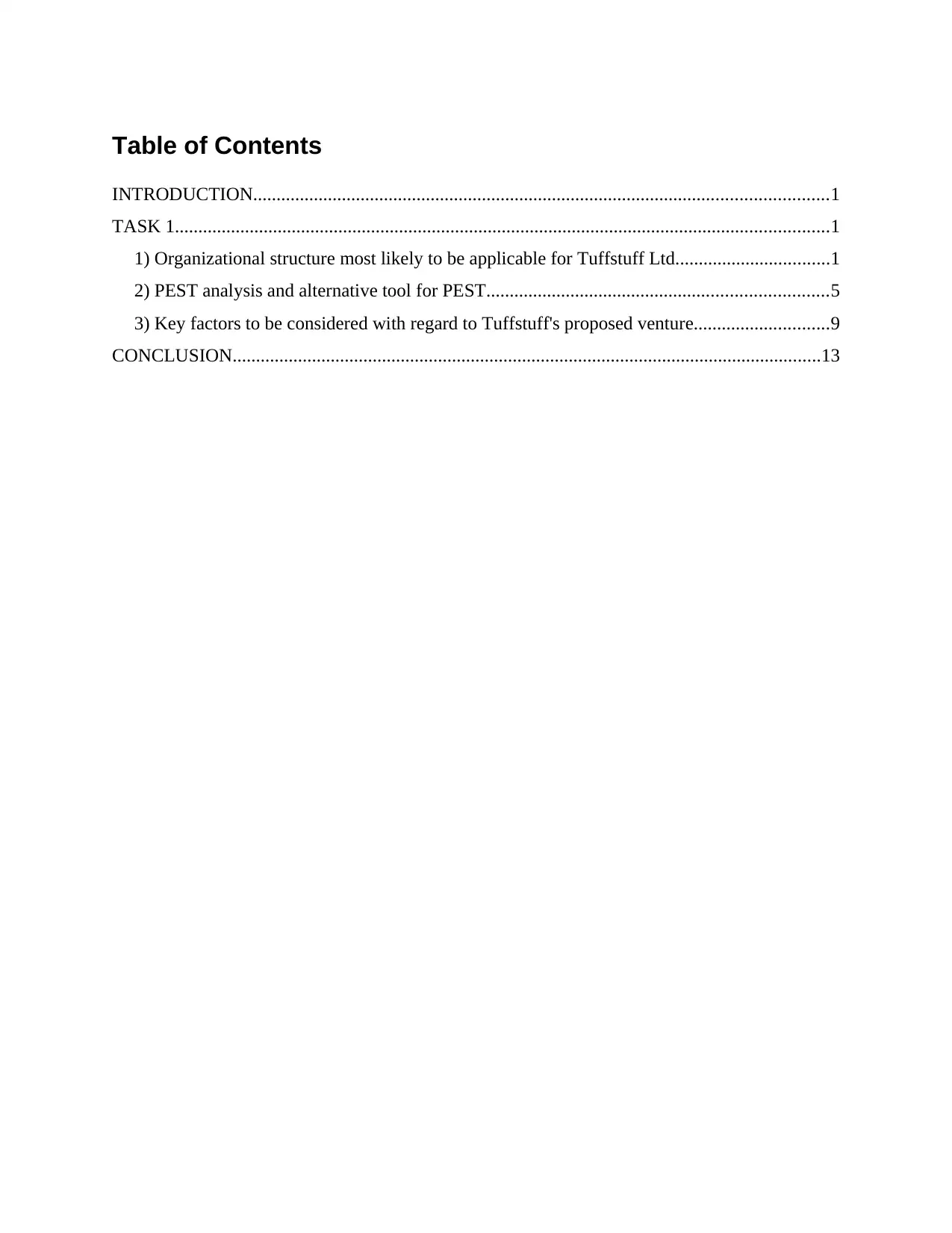
Table of Contents
INTRODUCTION...........................................................................................................................1
TASK 1............................................................................................................................................1
1) Organizational structure most likely to be applicable for Tuffstuff Ltd.................................1
2) PEST analysis and alternative tool for PEST.........................................................................5
3) Key factors to be considered with regard to Tuffstuff's proposed venture.............................9
CONCLUSION..............................................................................................................................13
INTRODUCTION...........................................................................................................................1
TASK 1............................................................................................................................................1
1) Organizational structure most likely to be applicable for Tuffstuff Ltd.................................1
2) PEST analysis and alternative tool for PEST.........................................................................5
3) Key factors to be considered with regard to Tuffstuff's proposed venture.............................9
CONCLUSION..............................................................................................................................13
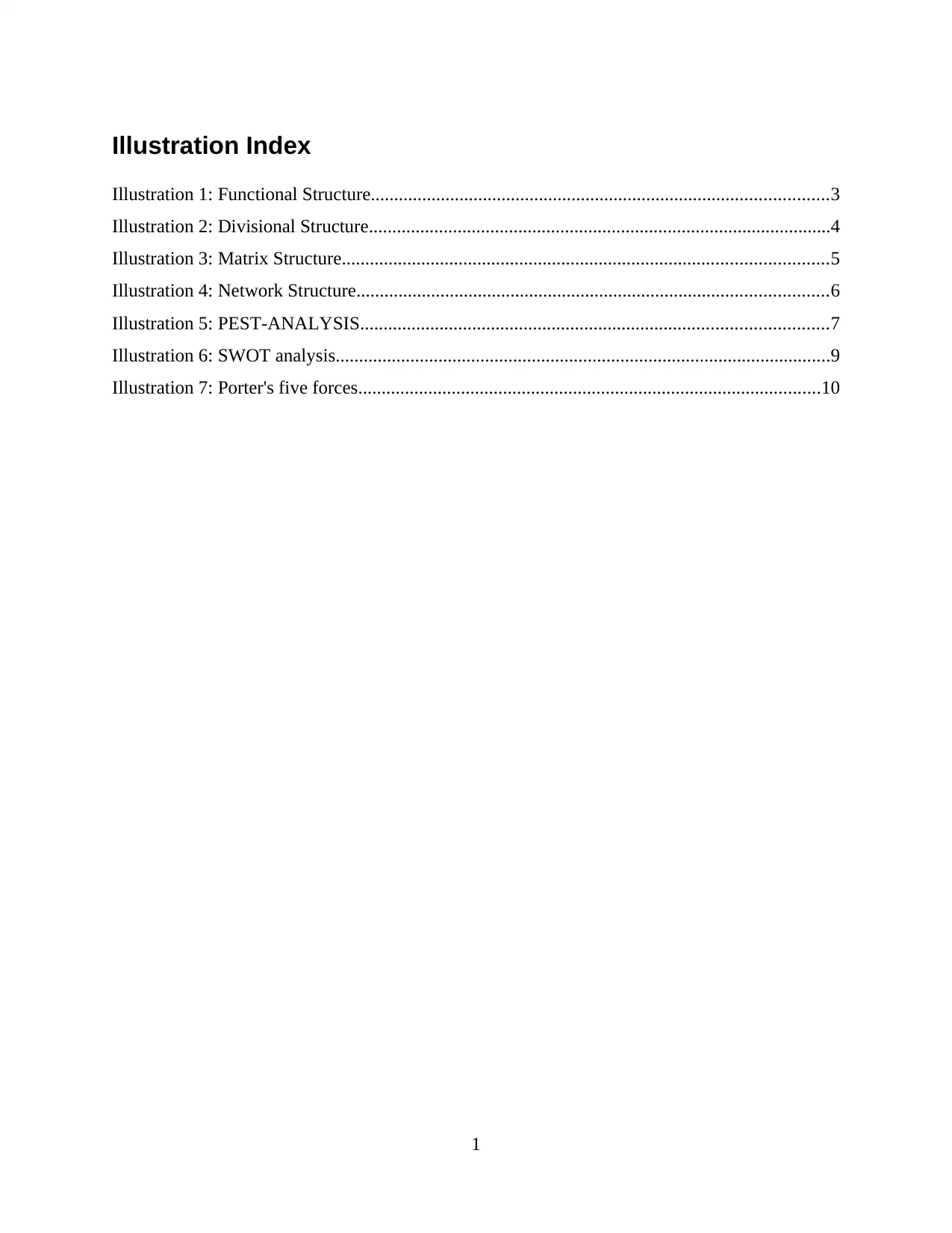
Illustration Index
Illustration 1: Functional Structure..................................................................................................3
Illustration 2: Divisional Structure...................................................................................................4
Illustration 3: Matrix Structure........................................................................................................5
Illustration 4: Network Structure.....................................................................................................6
Illustration 5: PEST-ANALYSIS....................................................................................................7
Illustration 6: SWOT analysis..........................................................................................................9
Illustration 7: Porter's five forces...................................................................................................10
1
Illustration 1: Functional Structure..................................................................................................3
Illustration 2: Divisional Structure...................................................................................................4
Illustration 3: Matrix Structure........................................................................................................5
Illustration 4: Network Structure.....................................................................................................6
Illustration 5: PEST-ANALYSIS....................................................................................................7
Illustration 6: SWOT analysis..........................................................................................................9
Illustration 7: Porter's five forces...................................................................................................10
1
⊘ This is a preview!⊘
Do you want full access?
Subscribe today to unlock all pages.

Trusted by 1+ million students worldwide
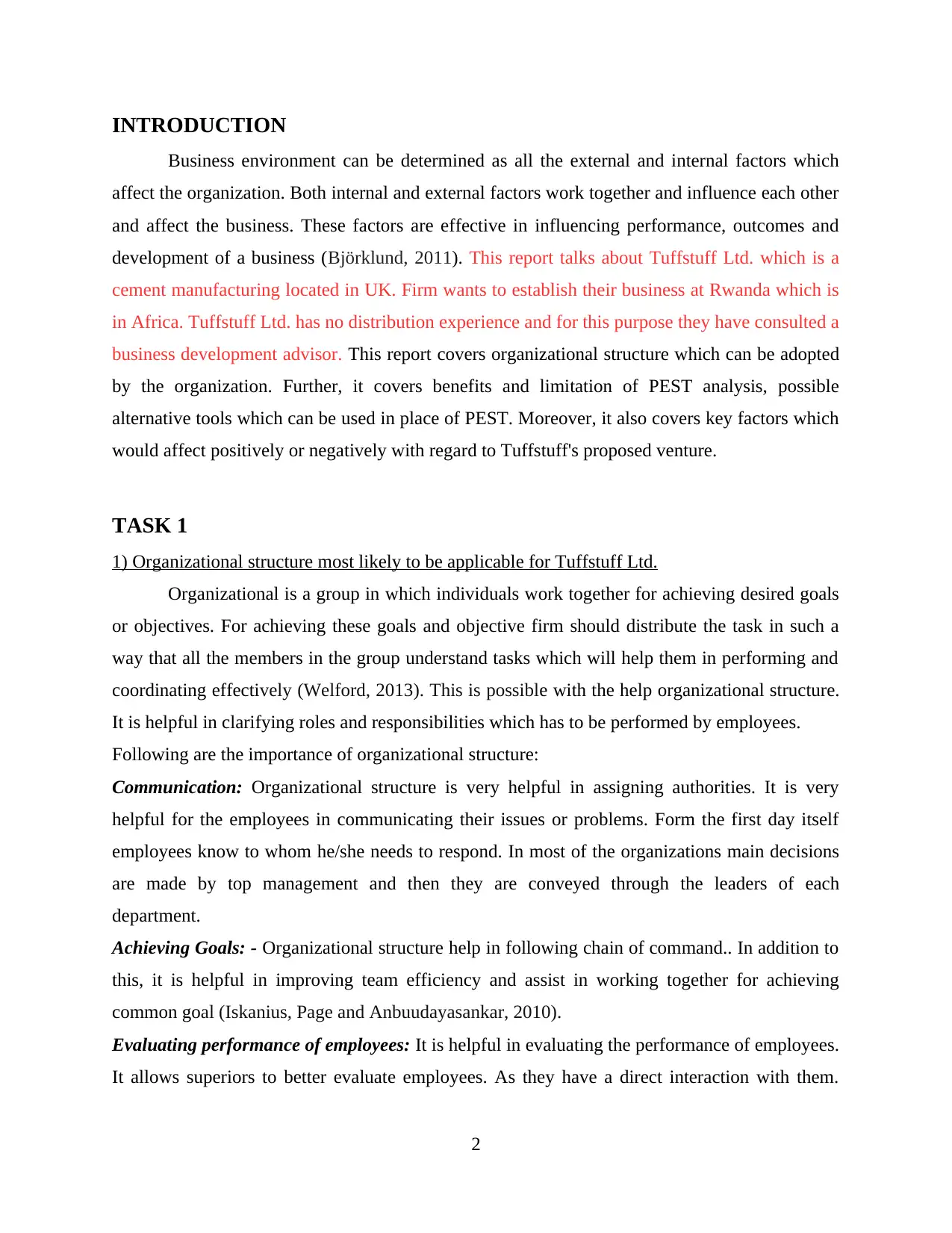
INTRODUCTION
Business environment can be determined as all the external and internal factors which
affect the organization. Both internal and external factors work together and influence each other
and affect the business. These factors are effective in influencing performance, outcomes and
development of a business (Björklund, 2011). This report talks about Tuffstuff Ltd. which is a
cement manufacturing located in UK. Firm wants to establish their business at Rwanda which is
in Africa. Tuffstuff Ltd. has no distribution experience and for this purpose they have consulted a
business development advisor. This report covers organizational structure which can be adopted
by the organization. Further, it covers benefits and limitation of PEST analysis, possible
alternative tools which can be used in place of PEST. Moreover, it also covers key factors which
would affect positively or negatively with regard to Tuffstuff's proposed venture.
TASK 1
1) Organizational structure most likely to be applicable for Tuffstuff Ltd.
Organizational is a group in which individuals work together for achieving desired goals
or objectives. For achieving these goals and objective firm should distribute the task in such a
way that all the members in the group understand tasks which will help them in performing and
coordinating effectively (Welford, 2013). This is possible with the help organizational structure.
It is helpful in clarifying roles and responsibilities which has to be performed by employees.
Following are the importance of organizational structure:
Communication: Organizational structure is very helpful in assigning authorities. It is very
helpful for the employees in communicating their issues or problems. Form the first day itself
employees know to whom he/she needs to respond. In most of the organizations main decisions
are made by top management and then they are conveyed through the leaders of each
department.
Achieving Goals: - Organizational structure help in following chain of command.. In addition to
this, it is helpful in improving team efficiency and assist in working together for achieving
common goal (Iskanius, Page and Anbuudayasankar, 2010).
Evaluating performance of employees: It is helpful in evaluating the performance of employees.
It allows superiors to better evaluate employees. As they have a direct interaction with them.
2
Business environment can be determined as all the external and internal factors which
affect the organization. Both internal and external factors work together and influence each other
and affect the business. These factors are effective in influencing performance, outcomes and
development of a business (Björklund, 2011). This report talks about Tuffstuff Ltd. which is a
cement manufacturing located in UK. Firm wants to establish their business at Rwanda which is
in Africa. Tuffstuff Ltd. has no distribution experience and for this purpose they have consulted a
business development advisor. This report covers organizational structure which can be adopted
by the organization. Further, it covers benefits and limitation of PEST analysis, possible
alternative tools which can be used in place of PEST. Moreover, it also covers key factors which
would affect positively or negatively with regard to Tuffstuff's proposed venture.
TASK 1
1) Organizational structure most likely to be applicable for Tuffstuff Ltd.
Organizational is a group in which individuals work together for achieving desired goals
or objectives. For achieving these goals and objective firm should distribute the task in such a
way that all the members in the group understand tasks which will help them in performing and
coordinating effectively (Welford, 2013). This is possible with the help organizational structure.
It is helpful in clarifying roles and responsibilities which has to be performed by employees.
Following are the importance of organizational structure:
Communication: Organizational structure is very helpful in assigning authorities. It is very
helpful for the employees in communicating their issues or problems. Form the first day itself
employees know to whom he/she needs to respond. In most of the organizations main decisions
are made by top management and then they are conveyed through the leaders of each
department.
Achieving Goals: - Organizational structure help in following chain of command.. In addition to
this, it is helpful in improving team efficiency and assist in working together for achieving
common goal (Iskanius, Page and Anbuudayasankar, 2010).
Evaluating performance of employees: It is helpful in evaluating the performance of employees.
It allows superiors to better evaluate employees. As they have a direct interaction with them.
2
Paraphrase This Document
Need a fresh take? Get an instant paraphrase of this document with our AI Paraphraser
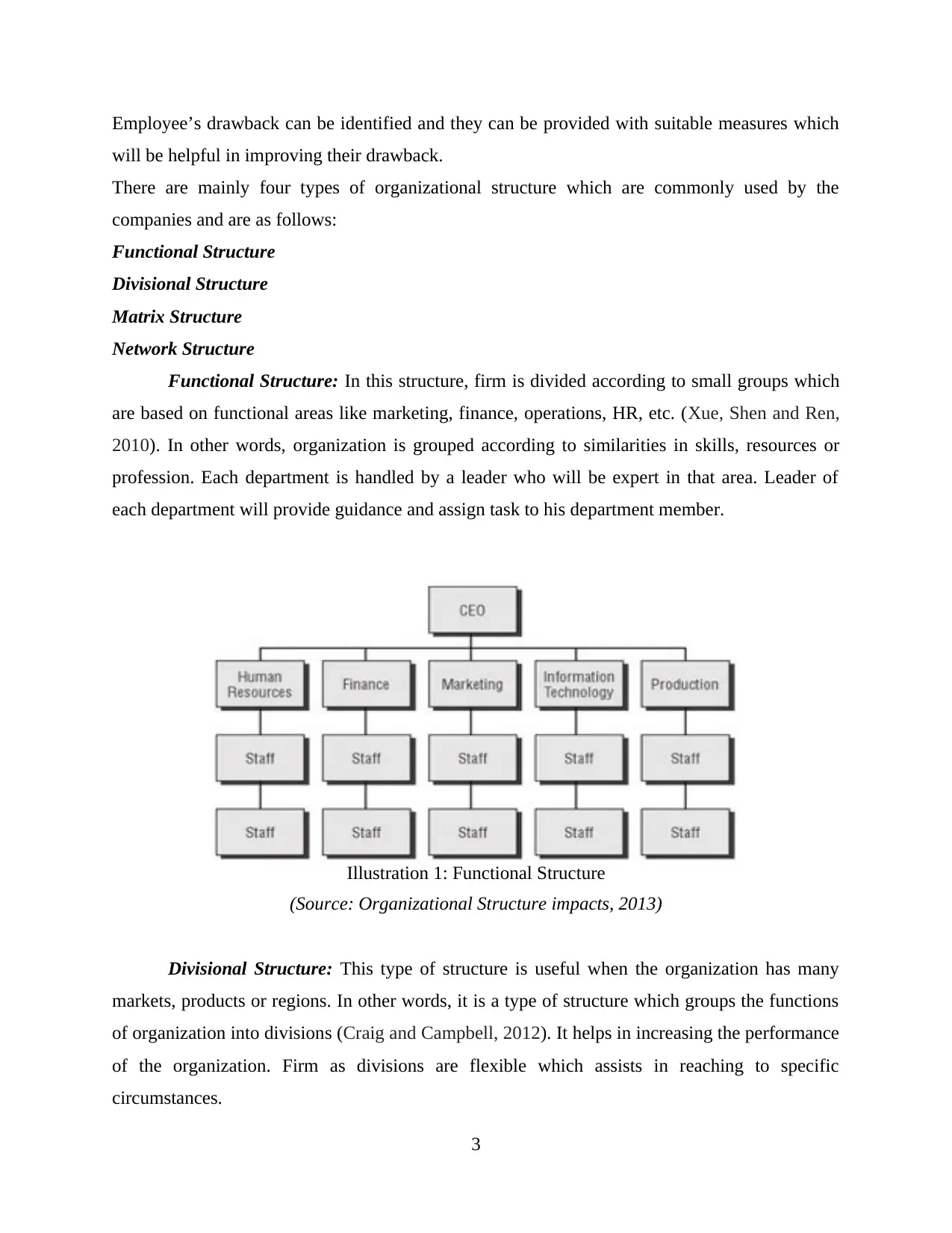
Employee’s drawback can be identified and they can be provided with suitable measures which
will be helpful in improving their drawback.
There are mainly four types of organizational structure which are commonly used by the
companies and are as follows:
Functional Structure
Divisional Structure
Matrix Structure
Network Structure
Functional Structure: In this structure, firm is divided according to small groups which
are based on functional areas like marketing, finance, operations, HR, etc. (Xue, Shen and Ren,
2010). In other words, organization is grouped according to similarities in skills, resources or
profession. Each department is handled by a leader who will be expert in that area. Leader of
each department will provide guidance and assign task to his department member.
Divisional Structure: This type of structure is useful when the organization has many
markets, products or regions. In other words, it is a type of structure which groups the functions
of organization into divisions (Craig and Campbell, 2012). It helps in increasing the performance
of the organization. Firm as divisions are flexible which assists in reaching to specific
circumstances.
3
Illustration 1: Functional Structure
(Source: Organizational Structure impacts, 2013)
will be helpful in improving their drawback.
There are mainly four types of organizational structure which are commonly used by the
companies and are as follows:
Functional Structure
Divisional Structure
Matrix Structure
Network Structure
Functional Structure: In this structure, firm is divided according to small groups which
are based on functional areas like marketing, finance, operations, HR, etc. (Xue, Shen and Ren,
2010). In other words, organization is grouped according to similarities in skills, resources or
profession. Each department is handled by a leader who will be expert in that area. Leader of
each department will provide guidance and assign task to his department member.
Divisional Structure: This type of structure is useful when the organization has many
markets, products or regions. In other words, it is a type of structure which groups the functions
of organization into divisions (Craig and Campbell, 2012). It helps in increasing the performance
of the organization. Firm as divisions are flexible which assists in reaching to specific
circumstances.
3
Illustration 1: Functional Structure
(Source: Organizational Structure impacts, 2013)
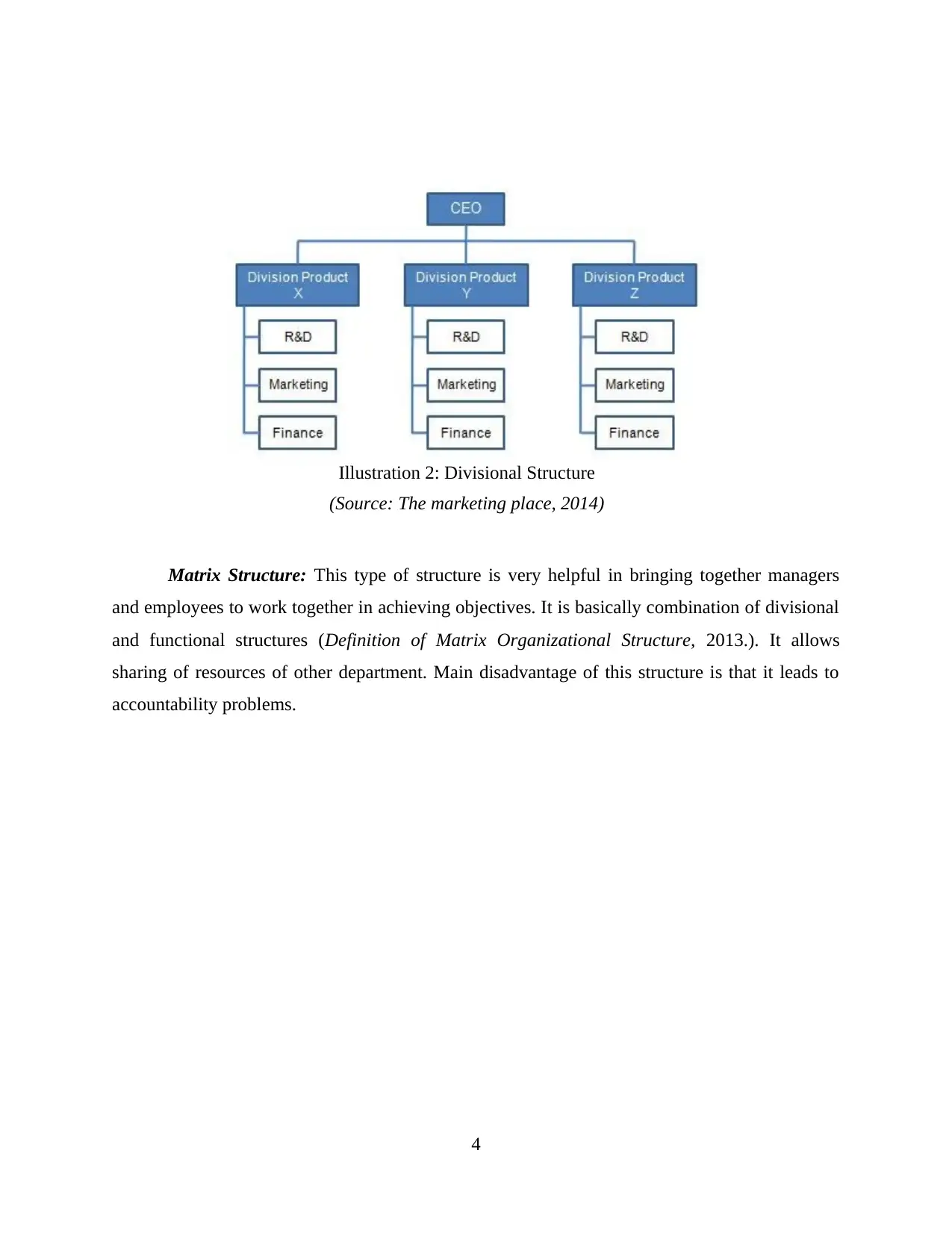
Matrix Structure: This type of structure is very helpful in bringing together managers
and employees to work together in achieving objectives. It is basically combination of divisional
and functional structures (Definition of Matrix Organizational Structure, 2013.). It allows
sharing of resources of other department. Main disadvantage of this structure is that it leads to
accountability problems.
4
Illustration 2: Divisional Structure
(Source: The marketing place, 2014)
and employees to work together in achieving objectives. It is basically combination of divisional
and functional structures (Definition of Matrix Organizational Structure, 2013.). It allows
sharing of resources of other department. Main disadvantage of this structure is that it leads to
accountability problems.
4
Illustration 2: Divisional Structure
(Source: The marketing place, 2014)
⊘ This is a preview!⊘
Do you want full access?
Subscribe today to unlock all pages.

Trusted by 1+ million students worldwide
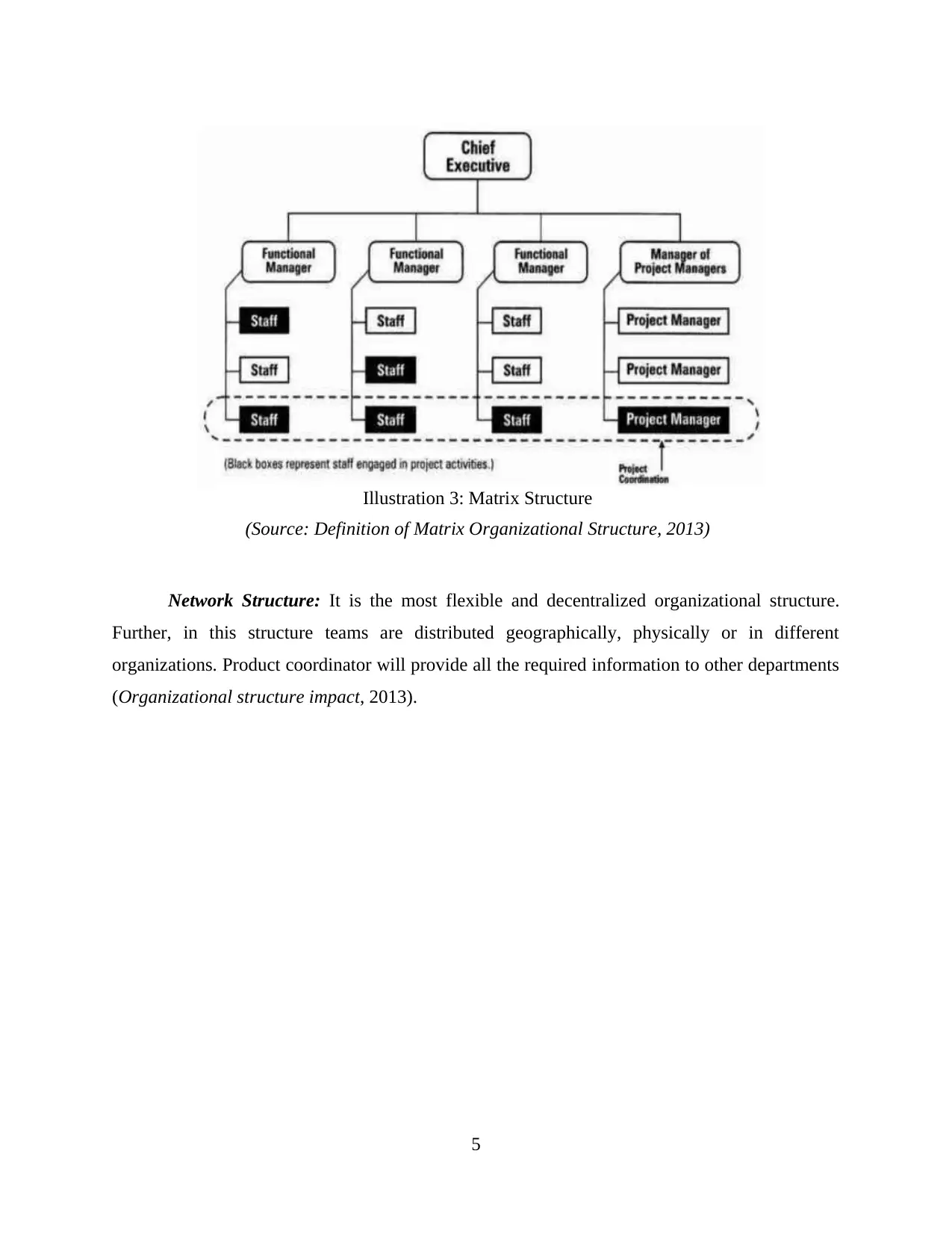
Network Structure: It is the most flexible and decentralized organizational structure.
Further, in this structure teams are distributed geographically, physically or in different
organizations. Product coordinator will provide all the required information to other departments
(Organizational structure impact, 2013).
5
Illustration 3: Matrix Structure
(Source: Definition of Matrix Organizational Structure, 2013)
Further, in this structure teams are distributed geographically, physically or in different
organizations. Product coordinator will provide all the required information to other departments
(Organizational structure impact, 2013).
5
Illustration 3: Matrix Structure
(Source: Definition of Matrix Organizational Structure, 2013)
Paraphrase This Document
Need a fresh take? Get an instant paraphrase of this document with our AI Paraphraser
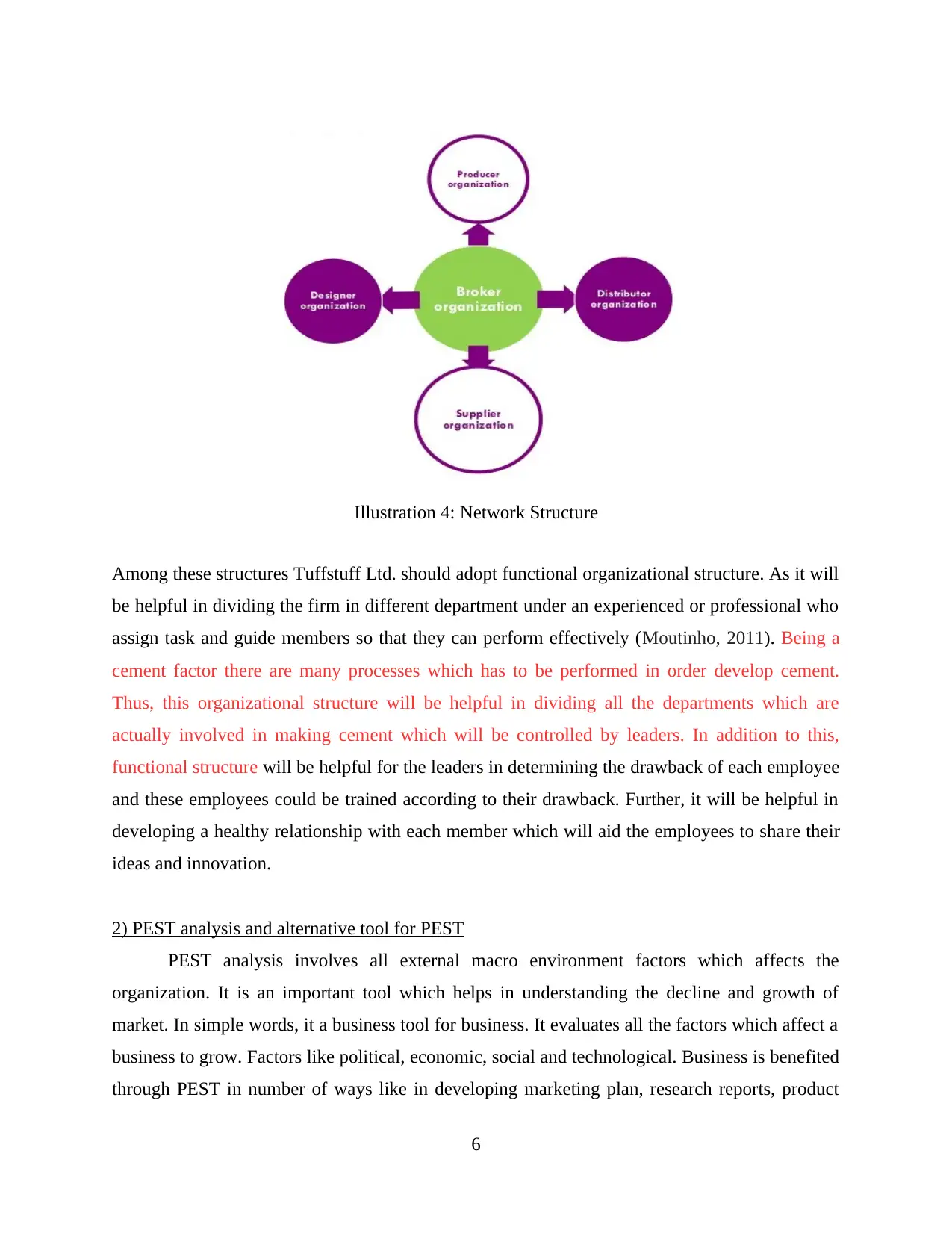
Among these structures Tuffstuff Ltd. should adopt functional organizational structure. As it will
be helpful in dividing the firm in different department under an experienced or professional who
assign task and guide members so that they can perform effectively (Moutinho, 2011). Being a
cement factor there are many processes which has to be performed in order develop cement.
Thus, this organizational structure will be helpful in dividing all the departments which are
actually involved in making cement which will be controlled by leaders. In addition to this,
functional structure will be helpful for the leaders in determining the drawback of each employee
and these employees could be trained according to their drawback. Further, it will be helpful in
developing a healthy relationship with each member which will aid the employees to share their
ideas and innovation.
2) PEST analysis and alternative tool for PEST
PEST analysis involves all external macro environment factors which affects the
organization. It is an important tool which helps in understanding the decline and growth of
market. In simple words, it a business tool for business. It evaluates all the factors which affect a
business to grow. Factors like political, economic, social and technological. Business is benefited
through PEST in number of ways like in developing marketing plan, research reports, product
6
Illustration 4: Network Structure
be helpful in dividing the firm in different department under an experienced or professional who
assign task and guide members so that they can perform effectively (Moutinho, 2011). Being a
cement factor there are many processes which has to be performed in order develop cement.
Thus, this organizational structure will be helpful in dividing all the departments which are
actually involved in making cement which will be controlled by leaders. In addition to this,
functional structure will be helpful for the leaders in determining the drawback of each employee
and these employees could be trained according to their drawback. Further, it will be helpful in
developing a healthy relationship with each member which will aid the employees to share their
ideas and innovation.
2) PEST analysis and alternative tool for PEST
PEST analysis involves all external macro environment factors which affects the
organization. It is an important tool which helps in understanding the decline and growth of
market. In simple words, it a business tool for business. It evaluates all the factors which affect a
business to grow. Factors like political, economic, social and technological. Business is benefited
through PEST in number of ways like in developing marketing plan, research reports, product
6
Illustration 4: Network Structure
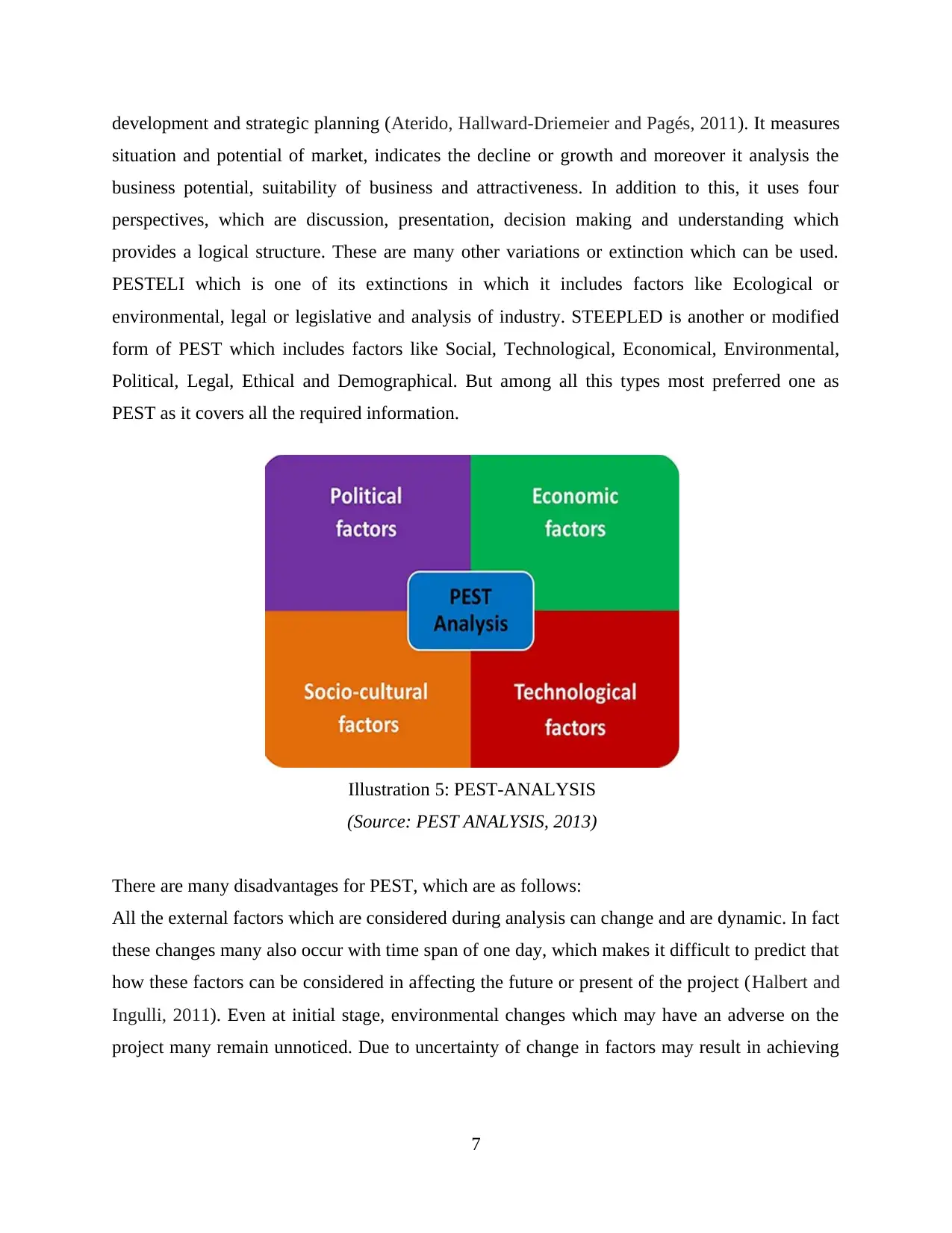
development and strategic planning (Aterido, Hallward-Driemeier and Pagés, 2011). It measures
situation and potential of market, indicates the decline or growth and moreover it analysis the
business potential, suitability of business and attractiveness. In addition to this, it uses four
perspectives, which are discussion, presentation, decision making and understanding which
provides a logical structure. These are many other variations or extinction which can be used.
PESTELI which is one of its extinctions in which it includes factors like Ecological or
environmental, legal or legislative and analysis of industry. STEEPLED is another or modified
form of PEST which includes factors like Social, Technological, Economical, Environmental,
Political, Legal, Ethical and Demographical. But among all this types most preferred one as
PEST as it covers all the required information.
There are many disadvantages for PEST, which are as follows:
All the external factors which are considered during analysis can change and are dynamic. In fact
these changes many also occur with time span of one day, which makes it difficult to predict that
how these factors can be considered in affecting the future or present of the project (Halbert and
Ingulli, 2011). Even at initial stage, environmental changes which may have an adverse on the
project many remain unnoticed. Due to uncertainty of change in factors may result in achieving
7
Illustration 5: PEST-ANALYSIS
(Source: PEST ANALYSIS, 2013)
situation and potential of market, indicates the decline or growth and moreover it analysis the
business potential, suitability of business and attractiveness. In addition to this, it uses four
perspectives, which are discussion, presentation, decision making and understanding which
provides a logical structure. These are many other variations or extinction which can be used.
PESTELI which is one of its extinctions in which it includes factors like Ecological or
environmental, legal or legislative and analysis of industry. STEEPLED is another or modified
form of PEST which includes factors like Social, Technological, Economical, Environmental,
Political, Legal, Ethical and Demographical. But among all this types most preferred one as
PEST as it covers all the required information.
There are many disadvantages for PEST, which are as follows:
All the external factors which are considered during analysis can change and are dynamic. In fact
these changes many also occur with time span of one day, which makes it difficult to predict that
how these factors can be considered in affecting the future or present of the project (Halbert and
Ingulli, 2011). Even at initial stage, environmental changes which may have an adverse on the
project many remain unnoticed. Due to uncertainty of change in factors may result in achieving
7
Illustration 5: PEST-ANALYSIS
(Source: PEST ANALYSIS, 2013)
⊘ This is a preview!⊘
Do you want full access?
Subscribe today to unlock all pages.

Trusted by 1+ million students worldwide
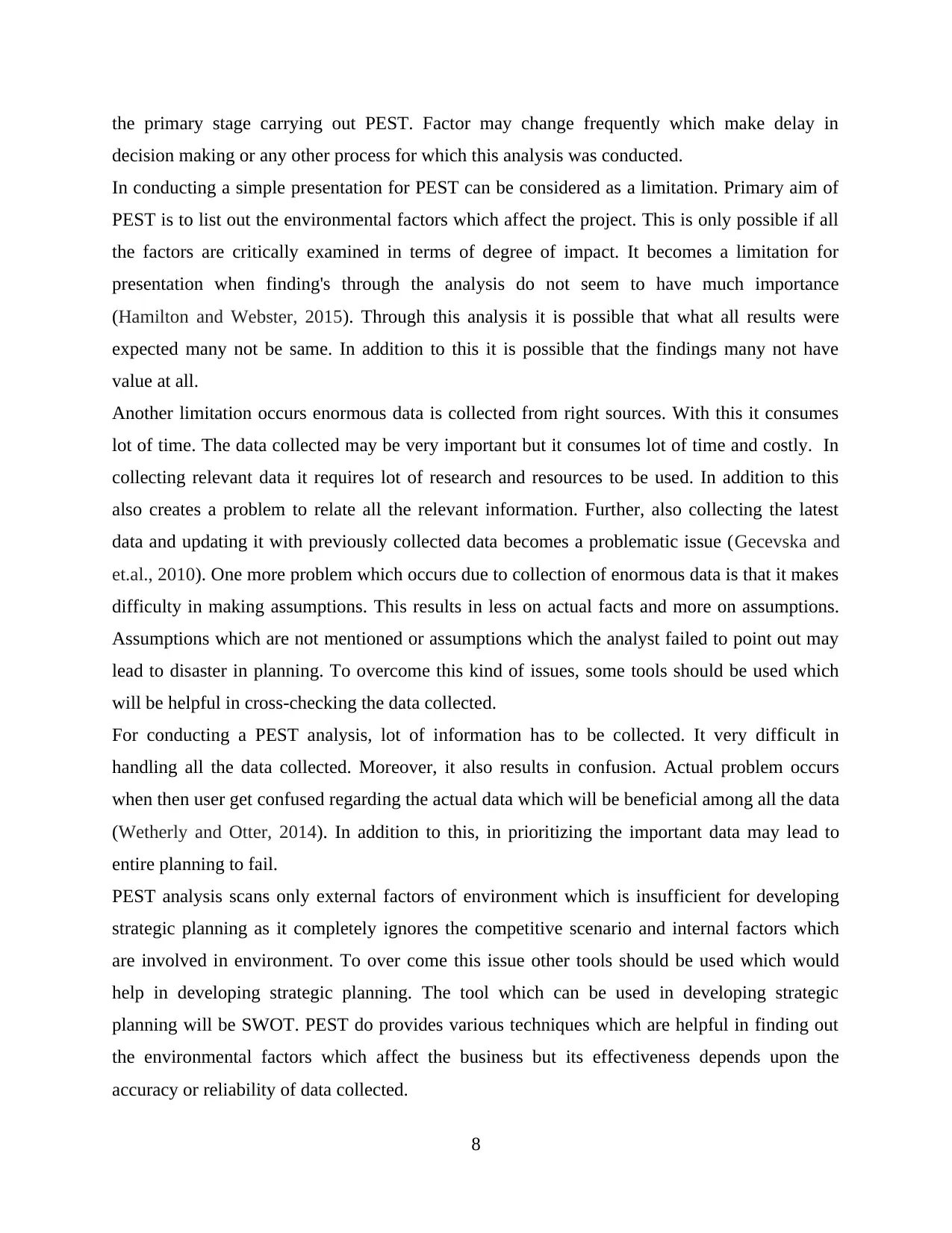
the primary stage carrying out PEST. Factor may change frequently which make delay in
decision making or any other process for which this analysis was conducted.
In conducting a simple presentation for PEST can be considered as a limitation. Primary aim of
PEST is to list out the environmental factors which affect the project. This is only possible if all
the factors are critically examined in terms of degree of impact. It becomes a limitation for
presentation when finding's through the analysis do not seem to have much importance
(Hamilton and Webster, 2015). Through this analysis it is possible that what all results were
expected many not be same. In addition to this it is possible that the findings many not have
value at all.
Another limitation occurs enormous data is collected from right sources. With this it consumes
lot of time. The data collected may be very important but it consumes lot of time and costly. In
collecting relevant data it requires lot of research and resources to be used. In addition to this
also creates a problem to relate all the relevant information. Further, also collecting the latest
data and updating it with previously collected data becomes a problematic issue (Gecevska and
et.al., 2010). One more problem which occurs due to collection of enormous data is that it makes
difficulty in making assumptions. This results in less on actual facts and more on assumptions.
Assumptions which are not mentioned or assumptions which the analyst failed to point out may
lead to disaster in planning. To overcome this kind of issues, some tools should be used which
will be helpful in cross-checking the data collected.
For conducting a PEST analysis, lot of information has to be collected. It very difficult in
handling all the data collected. Moreover, it also results in confusion. Actual problem occurs
when then user get confused regarding the actual data which will be beneficial among all the data
(Wetherly and Otter, 2014). In addition to this, in prioritizing the important data may lead to
entire planning to fail.
PEST analysis scans only external factors of environment which is insufficient for developing
strategic planning as it completely ignores the competitive scenario and internal factors which
are involved in environment. To over come this issue other tools should be used which would
help in developing strategic planning. The tool which can be used in developing strategic
planning will be SWOT. PEST do provides various techniques which are helpful in finding out
the environmental factors which affect the business but its effectiveness depends upon the
accuracy or reliability of data collected.
8
decision making or any other process for which this analysis was conducted.
In conducting a simple presentation for PEST can be considered as a limitation. Primary aim of
PEST is to list out the environmental factors which affect the project. This is only possible if all
the factors are critically examined in terms of degree of impact. It becomes a limitation for
presentation when finding's through the analysis do not seem to have much importance
(Hamilton and Webster, 2015). Through this analysis it is possible that what all results were
expected many not be same. In addition to this it is possible that the findings many not have
value at all.
Another limitation occurs enormous data is collected from right sources. With this it consumes
lot of time. The data collected may be very important but it consumes lot of time and costly. In
collecting relevant data it requires lot of research and resources to be used. In addition to this
also creates a problem to relate all the relevant information. Further, also collecting the latest
data and updating it with previously collected data becomes a problematic issue (Gecevska and
et.al., 2010). One more problem which occurs due to collection of enormous data is that it makes
difficulty in making assumptions. This results in less on actual facts and more on assumptions.
Assumptions which are not mentioned or assumptions which the analyst failed to point out may
lead to disaster in planning. To overcome this kind of issues, some tools should be used which
will be helpful in cross-checking the data collected.
For conducting a PEST analysis, lot of information has to be collected. It very difficult in
handling all the data collected. Moreover, it also results in confusion. Actual problem occurs
when then user get confused regarding the actual data which will be beneficial among all the data
(Wetherly and Otter, 2014). In addition to this, in prioritizing the important data may lead to
entire planning to fail.
PEST analysis scans only external factors of environment which is insufficient for developing
strategic planning as it completely ignores the competitive scenario and internal factors which
are involved in environment. To over come this issue other tools should be used which would
help in developing strategic planning. The tool which can be used in developing strategic
planning will be SWOT. PEST do provides various techniques which are helpful in finding out
the environmental factors which affect the business but its effectiveness depends upon the
accuracy or reliability of data collected.
8
Paraphrase This Document
Need a fresh take? Get an instant paraphrase of this document with our AI Paraphraser
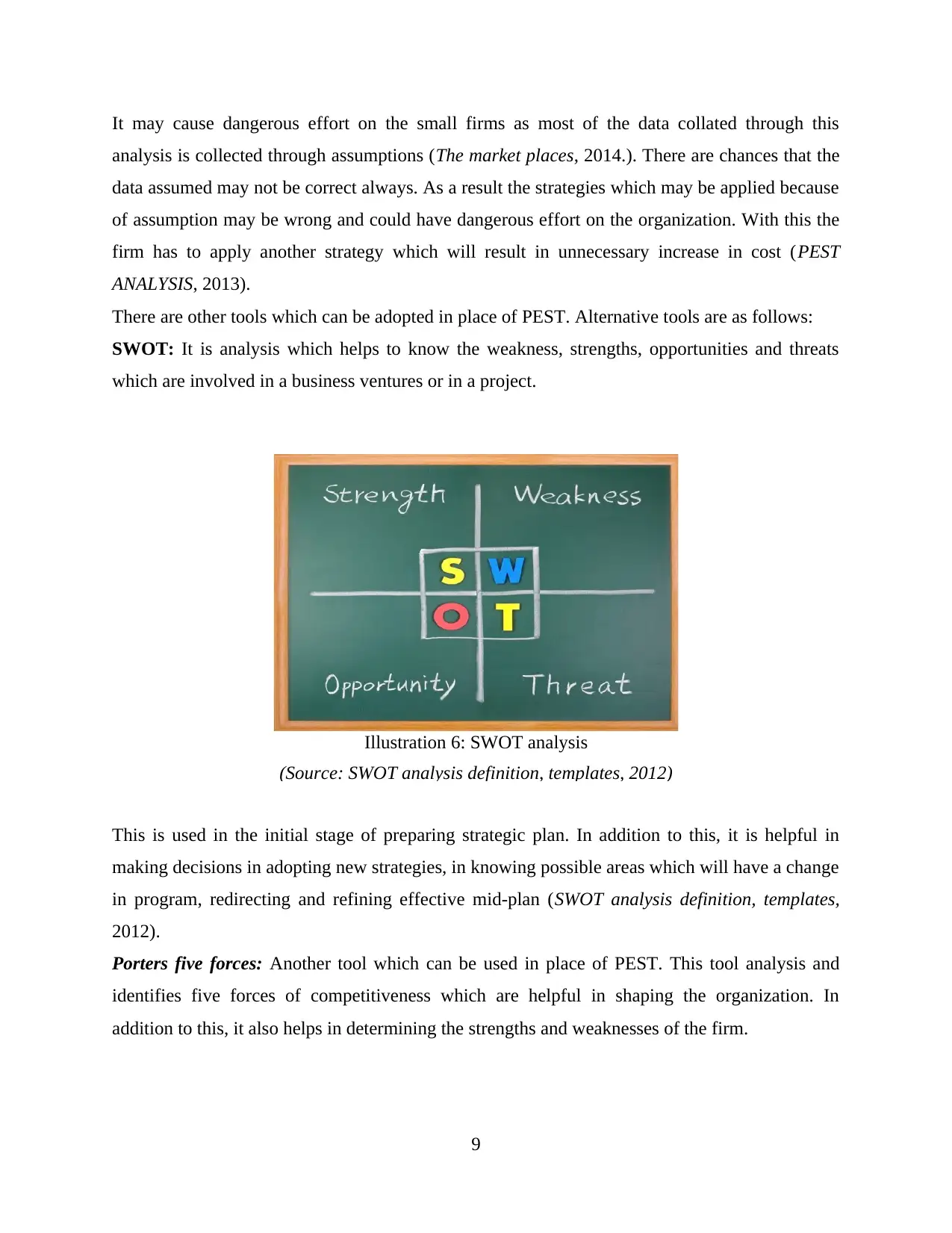
It may cause dangerous effort on the small firms as most of the data collated through this
analysis is collected through assumptions (The market places, 2014.). There are chances that the
data assumed may not be correct always. As a result the strategies which may be applied because
of assumption may be wrong and could have dangerous effort on the organization. With this the
firm has to apply another strategy which will result in unnecessary increase in cost (PEST
ANALYSIS, 2013).
There are other tools which can be adopted in place of PEST. Alternative tools are as follows:
SWOT: It is analysis which helps to know the weakness, strengths, opportunities and threats
which are involved in a business ventures or in a project.
This is used in the initial stage of preparing strategic plan. In addition to this, it is helpful in
making decisions in adopting new strategies, in knowing possible areas which will have a change
in program, redirecting and refining effective mid-plan (SWOT analysis definition, templates,
2012).
Porters five forces: Another tool which can be used in place of PEST. This tool analysis and
identifies five forces of competitiveness which are helpful in shaping the organization. In
addition to this, it also helps in determining the strengths and weaknesses of the firm.
9
Illustration 6: SWOT analysis
(Source: SWOT analysis definition, templates, 2012)
analysis is collected through assumptions (The market places, 2014.). There are chances that the
data assumed may not be correct always. As a result the strategies which may be applied because
of assumption may be wrong and could have dangerous effort on the organization. With this the
firm has to apply another strategy which will result in unnecessary increase in cost (PEST
ANALYSIS, 2013).
There are other tools which can be adopted in place of PEST. Alternative tools are as follows:
SWOT: It is analysis which helps to know the weakness, strengths, opportunities and threats
which are involved in a business ventures or in a project.
This is used in the initial stage of preparing strategic plan. In addition to this, it is helpful in
making decisions in adopting new strategies, in knowing possible areas which will have a change
in program, redirecting and refining effective mid-plan (SWOT analysis definition, templates,
2012).
Porters five forces: Another tool which can be used in place of PEST. This tool analysis and
identifies five forces of competitiveness which are helpful in shaping the organization. In
addition to this, it also helps in determining the strengths and weaknesses of the firm.
9
Illustration 6: SWOT analysis
(Source: SWOT analysis definition, templates, 2012)
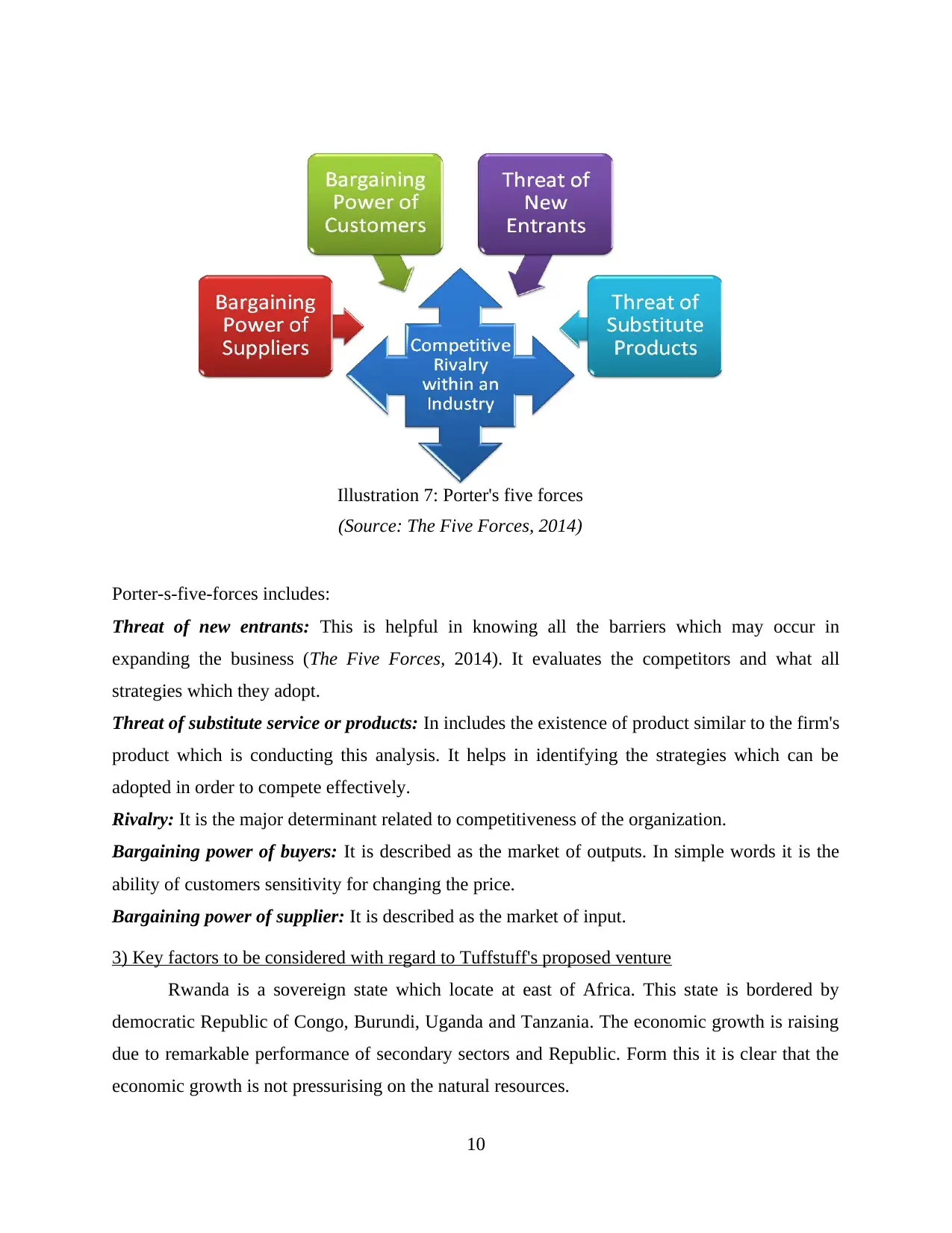
Porter-s-five-forces includes:
Threat of new entrants: This is helpful in knowing all the barriers which may occur in
expanding the business (The Five Forces, 2014). It evaluates the competitors and what all
strategies which they adopt.
Threat of substitute service or products: In includes the existence of product similar to the firm's
product which is conducting this analysis. It helps in identifying the strategies which can be
adopted in order to compete effectively.
Rivalry: It is the major determinant related to competitiveness of the organization.
Bargaining power of buyers: It is described as the market of outputs. In simple words it is the
ability of customers sensitivity for changing the price.
Bargaining power of supplier: It is described as the market of input.
3) Key factors to be considered with regard to Tuffstuff's proposed venture
Rwanda is a sovereign state which locate at east of Africa. This state is bordered by
democratic Republic of Congo, Burundi, Uganda and Tanzania. The economic growth is raising
due to remarkable performance of secondary sectors and Republic. Form this it is clear that the
economic growth is not pressurising on the natural resources.
10
Illustration 7: Porter's five forces
(Source: The Five Forces, 2014)
Threat of new entrants: This is helpful in knowing all the barriers which may occur in
expanding the business (The Five Forces, 2014). It evaluates the competitors and what all
strategies which they adopt.
Threat of substitute service or products: In includes the existence of product similar to the firm's
product which is conducting this analysis. It helps in identifying the strategies which can be
adopted in order to compete effectively.
Rivalry: It is the major determinant related to competitiveness of the organization.
Bargaining power of buyers: It is described as the market of outputs. In simple words it is the
ability of customers sensitivity for changing the price.
Bargaining power of supplier: It is described as the market of input.
3) Key factors to be considered with regard to Tuffstuff's proposed venture
Rwanda is a sovereign state which locate at east of Africa. This state is bordered by
democratic Republic of Congo, Burundi, Uganda and Tanzania. The economic growth is raising
due to remarkable performance of secondary sectors and Republic. Form this it is clear that the
economic growth is not pressurising on the natural resources.
10
Illustration 7: Porter's five forces
(Source: The Five Forces, 2014)
⊘ This is a preview!⊘
Do you want full access?
Subscribe today to unlock all pages.

Trusted by 1+ million students worldwide
1 out of 18
Related Documents
Your All-in-One AI-Powered Toolkit for Academic Success.
+13062052269
info@desklib.com
Available 24*7 on WhatsApp / Email
![[object Object]](/_next/static/media/star-bottom.7253800d.svg)
Unlock your academic potential
Copyright © 2020–2025 A2Z Services. All Rights Reserved. Developed and managed by ZUCOL.





